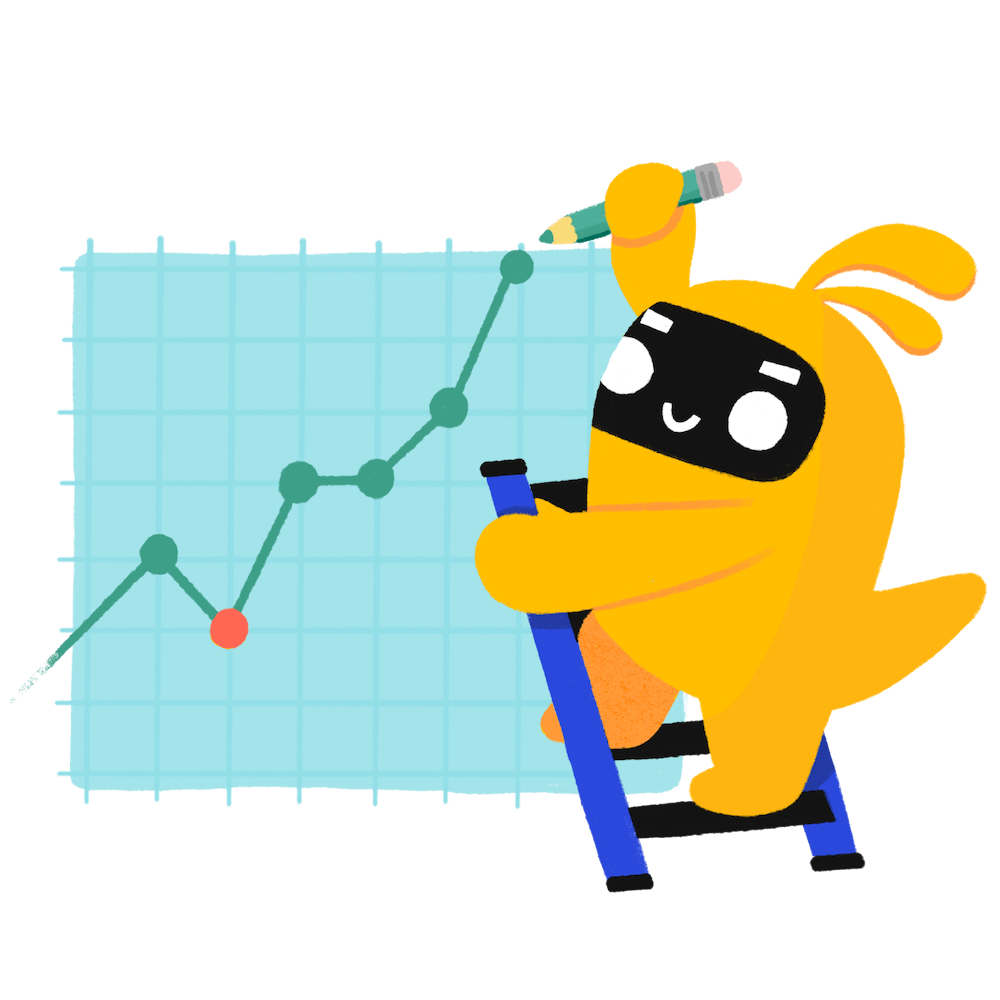14 customisable OKR examples for Engineers
What are Engineers OKRs?
The OKR acronym stands for Objectives and Key Results. It's a goal-setting framework that was introduced at Intel by Andy Grove in the 70s, and it became popular after John Doerr introduced it to Google in the 90s. OKRs helps teams has a shared language to set ambitious goals and track progress towards them.
OKRs are quickly gaining popularity as a goal-setting framework. But, it's not always easy to know how to write your goals, especially if it's your first time using OKRs.
To aid you in setting your goals, we have compiled a collection of OKR examples customized for Engineers. Take a look at the templates below for inspiration and guidance.
If you want to learn more about the framework, you can read our OKR guide online.
Building your own Engineers OKRs with AI
While we have some examples available, it's likely that you'll have specific scenarios that aren't covered here. You can use our free AI generator below or our more complete goal-setting system to generate your own OKRs.
Feel free to explore our tools:
- Use our free OKR generator
- Use Tability, a complete platform to set and track OKRs and initiatives, including a GPT-4 powered goal generator
Our customisable Engineers OKRs examples
You'll find below a list of Objectives and Key Results templates for Engineers. We also included strategic projects for each template to make it easier to understand the difference between key results and projects.
Hope you'll find this helpful!
1. OKRs to improve engineering performance and reliability
Build a world-class infrastructure
Increase Apdex above 0.95
Cache requests wherever possible
Identify and resolve to 5 application bottlenecks
Reduce build time to be under 5 minutes
Audit test suite to reduce duplicates
Switch to a more performing build infrastructure
Our stress tests show that we can support 10,000 concurrent users
2. OKRs to achieve promotion to software engineer 3
Achieve promotion to software engineer 3
Complete advanced software development certification
Mentor and provide guidance to junior software engineers
Schedule regular one-on-one meetings to discuss progress, challenges, and career goals
Offer constructive feedback and actionable suggestions for improvement on their code
Actively involve them in meaningful projects to gain real-world experience and build confidence
Provide resources and recommend learning opportunities to enhance their technical skills
Receive positive performance reviews from team members and supervisors
Regularly check in with team members and supervisors to receive feedback and updates
Actively listen to team members and supervisors, and address any concerns or suggestions
Set clear and measurable goals with team members and supervisors
Continuously improve skills and knowledge through training and professional development opportunities
Deliver three high-impact software projects successfully
Implement effective project management methodologies to ensure efficient coordination and communication
Define clear project goals, timelines, and deliverables for each software project
Assemble a skilled and dedicated team with the necessary expertise for each project
Regularly monitor and evaluate progress, making adjustments as needed to meet project objectives
3. OKRs to improve the quality of the data
Significantly improve the quality of the data
Reduce the number of data capture errors by 30%
Reduce delay for data availability from 24h to 4h
Close top 10 issues relating to data accuracy
4. OKRs to establish a proficient AI team with skilled ML engineers and product manager
Establish a proficient AI team with skilled ML engineers and product manager
Recruit an experienced AI product manager with a proven track record
Reach out to AI professionals on LinkedIn
Post the job ad on AI and tech-focused job boards
Draft a compelling job description for the AI product manager role
Conduct an effective onboarding program to integrate new hires into the team
Arrange team building activities to promote camaraderie
Develop a comprehensive orientation package for new hires
Assign mentors to guide newcomers in their roles
Interview and hire 5 qualified Machine Learning engineers
Conduct interviews and evaluate candidates based on benchmarks
Promote job vacancies on recruitment platforms and LinkedIn
Develop detailed job descriptions for Machine Learning engineer positions
5. OKRs to improve interoperability between data engineering teams
Improve interoperability between data engineering teams
Offer biweekly data interoperability training to 90% of data engineering teams
Identify 90% of data engineering teams for training
Develop a biweekly interoperability training schedule
Implement and monitor the data interoperability training
Reduce cross-team data discrepancies by 50%, ensuring increased data consistency
Regularly audit and correct data discrepancies across all teams
Implement a standardized data entry and management process for all teams
Utilize data synchronization tools for seamless data integration
Implement standardized data protocols across all teams increasing cross-collaboration by 30%
Train teams on new standardized protocols
Identify current data protocols in each team
Draft and propose unified data protocols
6. OKRs to reduce the cost of integrating data sources
Reduce the cost of data integration
Decrease the time to integrate new data sources from 2 days to 4h
Migrate data sources to Segment
Create a shared library to streamline integrations
Reduce the time to create new dashboards from 4 days to <1h
Adopt BI tool to allow users to create their own dashboards
10 teams have used successfully a self-serve dashboard creation system
7. OKRs to mitigate the risk associated with software maintenance
Mitigate the risk associated with software maintenance
Implement efficient risk management model for 90% of maintenance projects
Develop a comprehensive risk management model for maintenance projects
Apply the model to current maintenance projects for evaluation
Train project managers in risk management implementation
Achieve zero unresolved critical issues for all maintained software
Train staff in proactive problem identification and resolution
Implement regular system checks for software performance
Establish efficient issue reporting and resolution procedures
Provide tailored training for all software engineers on identified critical areas
Schedule and conduct tailored training sessions for engineers
Develop customized training programs focusing on these critical areas
Identify critical areas needing tailored training for software engineers
8. OKRs to tackle technical debt
Tackle technical debt generated by feature rush
Migrate 80% of projects to new UI library to reduce UI debt
Reduce percentage of issues tagged as debt by 30%
Reduce debt-related contact rate by 50%
9. OKRs to accelerate development via automation
Accelerate development through automation
100% of repos have a Continuous Delivery pipeline
Use Github Actions/Bitbucket Pipelines to automate deployments on every commit
Create automated deployment scripts for all repos
Increase code coverage from 30% to 60%
Reduce cycle time from 8 days to 8h
Reduce build time from 20min to 5min
Audit tests to find areas of improvements
Split tests to run in parallel when possible
10. OKRs to improve engineering release cycles
Significantly increase the speed of our development cycle
Improve developer NPS from 20 to 60
Reduce build times from 25 to under 5 mins
Reduce cycle time from 28 days to 6 days
Implement CD pipeline for the staging environment
Automate all deployment steps
11. OKRs to implement efficient test automation processes
Implement efficient test automation processes
Reduce manual testing work by 40% through customized automated scripts
Implement and monitor the automated scripts’ efficacy regularly
Develop customized automated scripts for these processes
Identify repeated manual testing processes suitable for automation
Successfully automate 70% of all repetitive tests while maintaining accuracy
Research suitable automation tools or software
Implement, monitor, and adjust automated processes accordingly
Identify and catalog all existing repetitive tests
Achieve a 30% decrease in software bugs and glitches through automated testing enhancement
Regularly evaluate and refine our testing processes
Train developers in advanced automated testing
Implement enhanced and rigorous automated testing protocols
12. OKRs to achieve great performance and reliability
Achieve amazing performance with a world-class infrastructure
Increase Apdex from 0.7 to 0.98
Add a CDN in front of resources
Implement caching wherever possible
Minify scripts and CSS
Improve crash free sessions from 75% to 95%
Reduce core pages load time to be under 3s
Reduce the number of paged issues by 40%
Identify and fix top 10 recurring issues
13. OKRs to increase code quality
Demonstrate incredible standards in code quality
100% of pull requests are reviewed by 2 developers
75% of the developers have gone through QA training
100% of repositories are using code linting and static code analysis
Reduce the percentage of QA-related broken builds by 60%
14. OKRs to deliver great user experience
Significantly improve the user experience through better performance
Decrease the number of production exceptions by 45%
Accelerate customer instance cold start time from 2min to 10s
Reduce API response time from 900ms to 450ms
Improve NPS from 15 to 35
Engineers OKR best practices to boost success
Generally speaking, your objectives should be ambitious yet achievable, and your key results should be measurable and time-bound (using the SMART framework can be helpful). It is also recommended to list strategic initiatives under your key results, as it'll help you avoid the common mistake of listing projects in your KRs.
Here are a couple of best practices extracted from our OKR implementation guide 👇
Tip #1: Limit the number of key results
The #1 role of OKRs is to help you and your team focus on what really matters. Business-as-usual activities will still be happening, but you do not need to track your entire roadmap in the OKRs.
We recommend having 3-4 objectives, and 3-4 key results per objective. A platform like Tability can run audits on your data to help you identify the plans that have too many goals.
 Tability's audit dashboard will highlight opportunities to improve OKRs
Tability's audit dashboard will highlight opportunities to improve OKRsTip #2: Commit to weekly OKR check-ins
Don't fall into the set-and-forget trap. It is important to adopt a weekly check-in process to get the full value of your OKRs and make your strategy agile – otherwise this is nothing more than a reporting exercise.
Being able to see trends for your key results will also keep yourself honest.
 Tability's check-ins will save you hours and increase transparency
Tability's check-ins will save you hours and increase transparencyTip #3: No more than 2 yellow statuses in a row
Yes, this is another tip for goal-tracking instead of goal-setting (but you'll get plenty of OKR examples above). But, once you have your goals defined, it will be your ability to keep the right sense of urgency that will make the difference.
As a rule of thumb, it's best to avoid having more than 2 yellow/at risk statuses in a row.
Make a call on the 3rd update. You should be either back on track, or off track. This sounds harsh but it's the best way to signal risks early enough to fix things.
How to turn your Engineers OKRs in a strategy map
OKRs without regular progress updates are just KPIs. You'll need to update progress on your OKRs every week to get the full benefits from the framework. Reviewing progress periodically has several advantages:
- It brings the goals back to the top of the mind
- It will highlight poorly set OKRs
- It will surface execution risks
- It improves transparency and accountability
We recommend using a spreadsheet for your first OKRs cycle. You'll need to get familiar with the scoring and tracking first. Then, you can scale your OKRs process by using a proper OKR-tracking tool for it.
 Tability's Strategy Map makes it easy to see all your org's OKRs
Tability's Strategy Map makes it easy to see all your org's OKRsIf you're not yet set on a tool, you can check out the 5 best OKR tracking templates guide to find the best way to monitor progress during the quarter.
More Engineers OKR templates
We have more templates to help you draft your team goals and OKRs.
OKRs to increase performance opportunities for musicians
OKRs to deepen understanding of customer needs
OKRs to cultivate an inclusive and engaging work environment for all employees
OKRs to improve search engine rankings for targeted keywords
OKRs to enhance productivity with increased automation and streamlined administration
OKRs to improve Efficiency of O&KR Maintenance Operations
OKRs resources
Here are a list of resources to help you adopt the Objectives and Key Results framework.
- To learn: What is the meaning of OKRs
- Blog posts: ODT Blog
- Success metrics: KPIs examples
Create more examples in our app
You can use Tability to create OKRs with AI – and keep yourself accountable 👀
Tability is a unique goal-tracking platform built to save hours at work and help teams stay on top of their goals.
 1 Create your workspace
1 Create your workspace 2 Build plans in seconds with AI
2 Build plans in seconds with AI 3Track your progress
3Track your progress